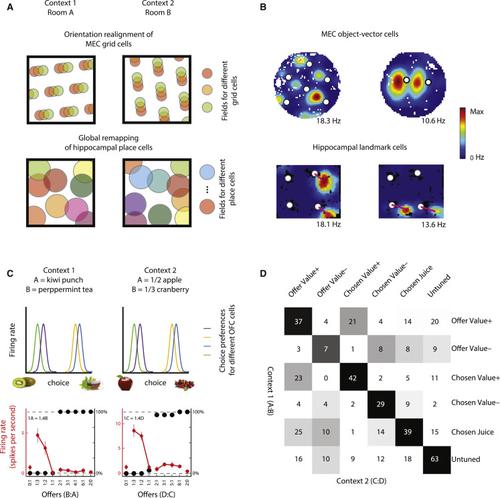Our official English website, www.x-mol.net, welcomes your feedback! (Note: you will need to create a separate account there.)
What Is a Cognitive Map? Organizing Knowledge for Flexible Behavior.
Neuron ( IF 14.7 ) Pub Date : 2018-Oct-24 , DOI: 10.1016/j.neuron.2018.10.002 Timothy E.J. Behrens , Timothy H. Muller , James C.R. Whittington , Shirley Mark , Alon B. Baram , Kimberly L. Stachenfeld , Zeb Kurth-Nelson
Neuron ( IF 14.7 ) Pub Date : 2018-Oct-24 , DOI: 10.1016/j.neuron.2018.10.002 Timothy E.J. Behrens , Timothy H. Muller , James C.R. Whittington , Shirley Mark , Alon B. Baram , Kimberly L. Stachenfeld , Zeb Kurth-Nelson

|
It is proposed that a cognitive map encoding the relationships between entities in the world supports flexible behavior, but the majority of the neural evidence for such a system comes from studies of spatial navigation. Recent work describing neuronal parallels between spatial and non-spatial behaviors has rekindled the notion of a systematic organization of knowledge across multiple domains. We review experimental evidence and theoretical frameworks that point to principles unifying these apparently disparate functions. These principles describe how to learn and use abstract, generalizable knowledge and suggest that map-like representations observed in a spatial context may be an instance of general coding mechanisms capable of organizing knowledge of all kinds. We highlight how artificial agents endowed with such principles exhibit flexible behavior and learn map-like representations observed in the brain. Finally, we speculate on how these principles may offer insight into the extreme generalizations, abstractions, and inferences that characterize human cognition.
中文翻译:

什么是认知图?组织知识以实现灵活的行为。
提出了一种编码世界上实体之间关系的认知图支持灵活的行为,但是这种系统的大部分神经证据来自空间导航的研究。描述空间行为和非空间行为之间神经元相似性的最新工作重新点燃了跨多个领域的系统知识组织的观念。我们回顾了实验证据和理论框架,它们指出了统一这些明显不同功能的原理。这些原则描述了如何学习和使用抽象的,可概括的知识,并建议在空间上下文中观察到的类似地图的表示形式可能是能够组织各种知识的通用编码机制的一个实例。我们强调具有这种原理的人工代理如何表现出灵活的行为并学习在大脑中观察到的地图状表示。最后,我们推测这些原理如何提供洞悉人类认知特征的极端概括,抽象和推论。
更新日期:2018-10-25
中文翻译:

什么是认知图?组织知识以实现灵活的行为。
提出了一种编码世界上实体之间关系的认知图支持灵活的行为,但是这种系统的大部分神经证据来自空间导航的研究。描述空间行为和非空间行为之间神经元相似性的最新工作重新点燃了跨多个领域的系统知识组织的观念。我们回顾了实验证据和理论框架,它们指出了统一这些明显不同功能的原理。这些原则描述了如何学习和使用抽象的,可概括的知识,并建议在空间上下文中观察到的类似地图的表示形式可能是能够组织各种知识的通用编码机制的一个实例。我们强调具有这种原理的人工代理如何表现出灵活的行为并学习在大脑中观察到的地图状表示。最后,我们推测这些原理如何提供洞悉人类认知特征的极端概括,抽象和推论。












































 京公网安备 11010802027423号
京公网安备 11010802027423号